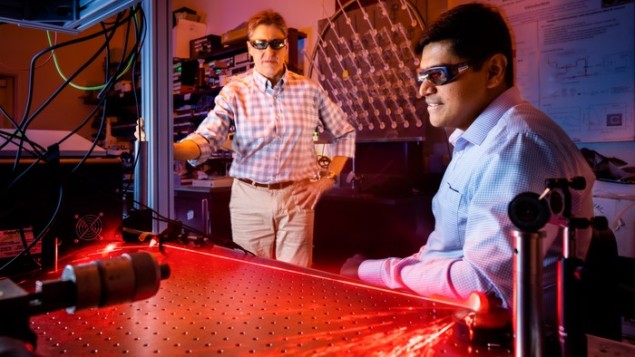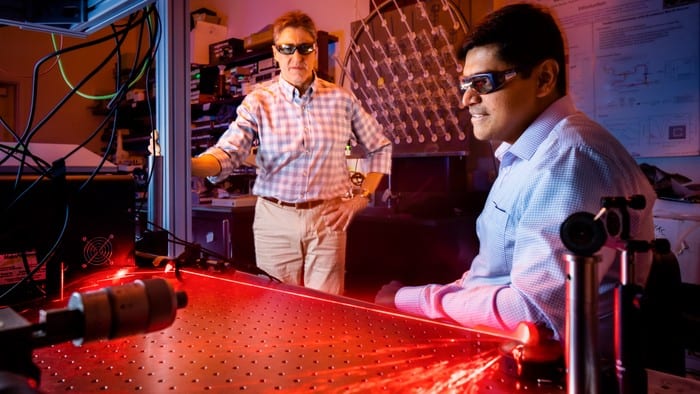
(Courtesy: Craig Fritz/Sandia National Laboratories)
Drawing from the latest advances in metasurfaces and nanophotonics, researchers in the US have designed a new light source that can steer beams of incoherent light over ultrashort timescales. Developed by Igal Brener and colleagues at Sandia National Laboratories in New Mexico, the source features a reconfigurable metasurface that is embedded with quantum dots. With further development, the concept could be used to improve virtual reality displays, sensors for autonomous vehicles and lighting systems.
An optical metasurface comprises a pattern of tiny components, each of which interacts with light. The optical properties of a metasurface arise from the collective effect of these components and metasurfaces can be used to create useful optical components such as flat lenses. Reconfigurable metasurfaces have optical properties that can be changed in controlled ways, opening up even more possible applications.
Recently, researchers have created reconfigurable metasurfaces that can steer laser light into specific directions. This was possible because laser light is coherent – all the light is in phase and at the same wavelength.
However, this beam steering has not been achieved for the incoherent light that is emitted by everyday sources such as LEDs and incandescent bulbs. “Currently, there is no ‘device’ that can emit light like an LED, and dynamically steer the emission into a particular direction at the same time,” Brener explains.
Quantum dots
In their study, the Sandia team addressed this shortcoming by designing a new metasurface. Their design features a quantum dot-embedded metasurface positioned on a refractive Bragg mirror. This is a mirror that is made up of multiple, periodically arranged layers with varying refractive indices. A Bragg mirror reflects light in a narrow band of wavelengths, while allowing other light to pass through.
Each quantum dot emits incoherent light and in their experiments, Brener’s team observed that the metasurface caused the incoherent light from the quantum dots to undergo phase changes. These changes restrain the light from spreading out over a wide range of angles – and instead cause much of the light to propagate in one direction.
The propagation direction of the light is controlled by firing two different laser pulses at the metasurface. One pulse temporarily modifies the refractive index of the metasurface, while the other pulse causes the quantum dots to emit light. It is this modification that steers the emitted light.
“We were able to steer the incoherent emission from quantum dots embedded into the metasurface over a 70-degree range,” Brener explains. What is more, the light can be steered over sub-picosecond timescales.
Brener points out that the design is mostly just a proof of concept for now, with much room for future improvement. “In a final device, this pattern would have to be reconfigured electrically, so that in the end you have a combination of an LED and several other contacts to reprogram the angle of emission,” he says.
More development needed
The team acknowledges that the commercialization of their technology is likely still several years away. Yet based on the results they have achieved so far, they hope that other researchers will start to think about the broad range of technologies that could benefit from controlled manipulation of incoherent light.

Microwave metasurface is reconfigured using stepping motors
“Maybe this type of device could replace steerable lasers,” Brener says, adding that it could be used to reduce energy consumption in lighting systems.
Other possible applications include small displays that can project holographic images directly onto the eye using low-power LEDs. This would be particularly useful for virtual and augmented reality devices — making them far simpler and cheaper than laser-based systems. Elsewhere, the metasurface could be useful in remote sensing. This includes the LIDAR systems used by self-driving vehicles to visualize their surroundings.
The research is described in Nature Photonics.
